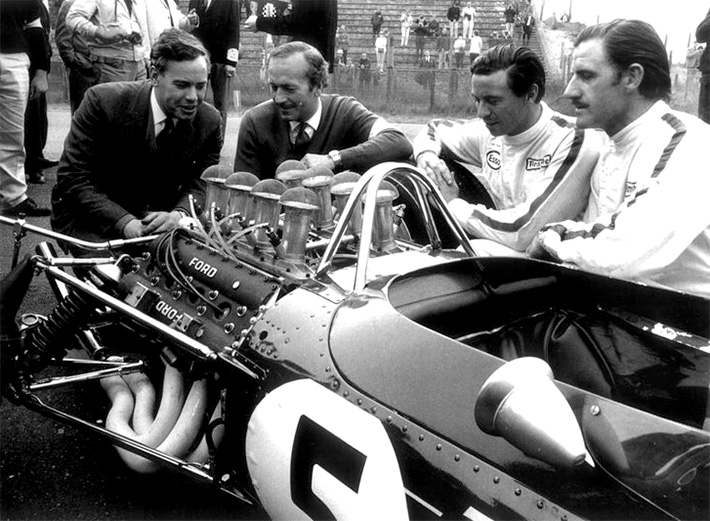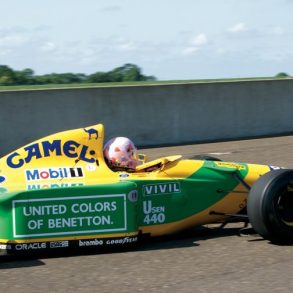Keith Duckworth Biography
Since the partnership was formed in 1958 by Mike Costin and Keith Duckworth along with Bill Brown and Benny Rood, Cosworth has become the most successful independent engine manufacturer in history with a string of driver and manufacturer titles to its credit in a wide range of formulae with impressive performances in Formula One, IndyCar, Champ Car, WRC, sportscars and MotoGP.

Meanwhile Mike Costin, the youngest of four children was born on the 10 of July 1929, in Hendon, England. As a young boy he was passionate about airplanes, and left school at 15 to take up a five-year trade apprenticeship at the De Havilland Aircraft Company. His eldest brother Frank, nine years older, was already working in aviation, helping to sort out the aerodynamic quirks of the twin-boom Vampire jet fighter. After two years De Havilland appreciated his practical intelligence and upgraded him to engineering apprentice. Costin did his National Service in the RAF, and then went back to De Havilland designing test rigs for, among other things, the Comet airliner.
After Duckworth left the military he asked Colin Chapman for a job with the newly young Lotus organization, having worked there during college vacations. Once hired he began to work on transmissions. He found Lotus not to his liking and after only two months he left to set up his own workshop. he was joined later by Mike Costin who had to see out his contract at Lotus.
Cosworth began life in a small workshop in London in 1958. Their initial work involved the further development of continue Coventry-Climax engines such that theirs were soon consistently beating the engines from Lotus. Things quickly grew and a move to larger premises was soon required. The company moved to north London, where it began working on the development of the Ford 105E engine for the newly introduced Formula Junior. Cosworth actually achieved its first victory when Jim Clark took a win in the Formula Junior category in his Lotus 18 at Goodwood in 1960. The first true racing engine from Cosworth was the 1-litre Formula Two SCA (Single-Cam A-series), introduced in time for the 1964 season which was based upon a Ford block. Cosworth’s solid working relationship with the British arm of the Ford Motor Company would continue to bear fruit.
At the beginning of 1966, Colin Chapman, of Lotus was on the lookout for a new engine to challenge those of Ferrari, BRM and Weslake, one that would replace the fire pump engine based Coventry Climax. For an initial estimate of the cost, Chapman approached Keith Duckworth of Cosworth Engineering, who suggested a cost of around £100,000. Chapman approached Ford and also David Brown of Aston Martin, each without initial success. Walter Hayes, head of Ford UK’s public relations department arranged diner for Chapman with Harley Copp, an American engineer who had backed and engineered Ford’s successful entry into NASCAR in the 1950s.
Hayes and Copp developed a business plan, which was backed by Ford UK’s new chairman Stanley Gillen, and approved by Ford’s Detroit head office as a two part plan – stage one would produce a four-cylinder twin-cam engine for Formula Two; by May 1967, stage two would produce a V-8 Formula One unit. In return, Chapman agreed to engineer “specials” for Ford, the first of which was 1963’s Lotus Cortina. In 1966, Duckworth signed a contract with Ford to develop a new three-litre Formula One engine, and the legendary DFV was born.
The engine got its first taste of victory in 1967, when Jim Clark driving the Lotus-Ford 49 again provided the maiden victory at the Dutch Grand Prix. The DFV, in subsequent development guises, went on to dominate the sport for 15 years and clinched 155 race wins during that time. A host of famous names benefited from Costin and Duckworth’s approach in Formula One. Jackie Stewart, Emerson Fittipaldi, Mario Andretti, James Hunt and Nelson Piquet all took championships using Cosworth engines during the 1970s. This period of sustained dominance in Formula One played a key part in making Cosworth a major name in motor racing around the world and a favorite with fans.













